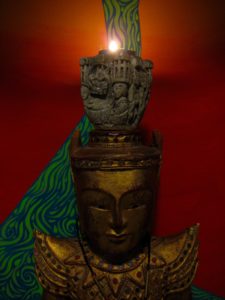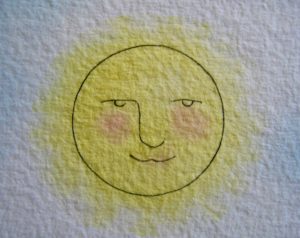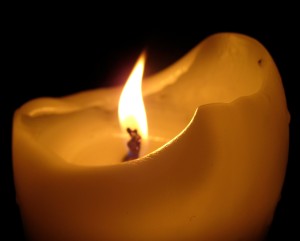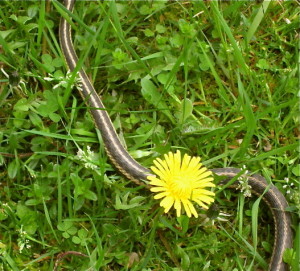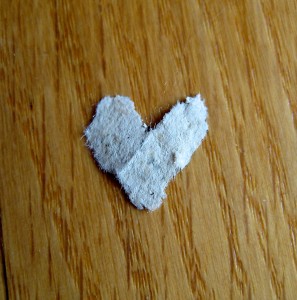
– Photo by Jan Ketchel
Shame is multilayered and multifaceted. It may be aroused by the thoughtless, unfeeling actions of another, or taken on due to a distorted, untruthful view of the self, the world, and reality. It may be instigated by a part of the self that knows better but goes ahead and does something shameful anyway.
It might only show up occasionally, when one is reminded of something one has done, not done, or had done to one. It’s an amorphous, shadowy, dark thing that’s hard to shed, and even harder to reckon with. It’s a bit like wrestling with an invisible opponent, because who can really see it? Except when it shows up, it is largely nonexistent, but say the word, “shame,” and you can feel the red heat of it spreading like wildfire.
In the story I am about to relate, having to do with a death and a chocolate cake, my own actions led me to the awareness of a deeper part of myself, a self I was not fully aware of, a part that apparently wanted me to know of its existence. In deep shame, I discovered something about myself that was shocking, abhorrent, sinful, despicable and mean, the epitome of sinister—all living within me!
Last week I wrote about the thief who lives inside me. It’s funny but I never felt ashamed of her, nor did I suffer shame around her actions. She was pretty straightforward and known, active often enough. I knew of her, the opposite of my good side, as we lived pretty much side by side, navigating life together, making decisions and choices, trying to figure out how we were going to reconcile with each other. The image of a good angel on one shoulder and a bad angel on the other comes to mind, both of whom constantly vie for attention. What I write about today is more covert, darker, hidden in the recesses of my soul.
It was 1966. I was 14. A good family friend had died, a man, an artist whom had taken an interest in me for my artistic abilities. He had a wife and a daughter. The daughter was 13 years older than me and also an artist. I considered her to be a mentor. When I heard that the man had died I was sad and wanted to do something for the family. It was in my nature to be generous and giving to others, in small personal ways, sending letters, making paintings and drawings, giving little handmade gifts.
At the time of the funeral I was visiting my cousin. She and I were not invited to the funeral; no children allowed. It was to be a small affair with the mourners invited to the family home afterwards for refreshments. My aunt, my cousin’s mother, would be going to the funeral and to the gathering afterwards.
I suggested to my cousin that we bake a cake for the gathering. My aunt thought it was a very nice idea and agreed to bring it with her. My cousin didn’t really understand my need to do something for these people whom she had no personal connection with, as I did, but I insisted. I had to do something, and in the end she was willing to join me in the project. So we set about making a cake.
We picked a recipe for a chocolate cake made from scratch. I was in charge of reading the recipe while my cousin got the ingredients together and measured everything into the mixing bowl. Everything was going along well enough as we came to the last ingredient in the recipe.
“¼ cup of salt,” I read to my cousin.
“Are you sure? That sounds like a lot of salt,” she said. I looked again.
“No, that’s right,” I said, “¼ cup of salt.”
“Check again,” she said.
I did. I saw the same thing every time I looked at the list of ingredients in the recipe: ¼ cup of salt.
“Okay,” my cousin said, a little warily, “in it goes, ¼ cup of salt!”
We mixed everything together, poured it into a baking pan, licked the beaters, and gagged! It tasted horrible! Too much salt! I went back to the cookbook, sure I had gotten it right, only to discover that I had read it totally wrong! It actually only called for a ¼ teaspoon of salt! My dyslexia had screwed things up royally.
We didn’t have enough eggs to bake a new cake, nor did we have the time, as my aunt would soon be heading off. We made an executive decision to bake the cake and see if it improved with heat. No deal! What should have been a thick and fluffy Bundt cake came out as flat as a pancake, looking more like a brownie than the grand cake we had envisioned! We debated over whether to cut a piece and taste it to see if it had indeed improved with baking.
“Do you think anyone would notice,” my cousin asked, “if we just cut a little piece?”
“Yes,” I said, “it would spoil the whole cake. We can’t send a cake with a slice taken out of it. Let’s sprinkle it with confectionary sugar and just hope for the best. Maybe no one will notice.”
For good measure, I topped it off with some purple violets, picked from outside the kitchen door, poked into the center of the cake. When we sent it off it looked perfectly fine; though a thin, dense cake, it looked rich and dark.
For the rest of the day my cousin and I were in agony. Though we laughed hysterically and somewhat meanly at the thought of people actually eating it, gagging as we had, we also knew what we had done.
Would they actually serve it? Would anyone eat it? What would they do or say if it turned out to be as bad as we expected it to be? As generous and thoughtful as the gift of a cake had originally been, we knew we had decided to test the fates, that a part of us was willing to risk all for a bad cake!
It did not go well. My aunt returned and confronted us. No one could eat the terrible cake. Did we know we had made a bad cake? We pleaded and pretended ignorance. But we knew what we had done and we also knew we would have to live out the consequences of our decision.
The story of the bad cake did not end there. The widow wrote my cousin and I a note thanking us for sending the cake; it had meant a lot to her that we’d been so thoughtful. She had served it with whipped cream and berries, but no one could eat it. “Was that some kind of joke?” she wrote. When I read her note I could feel her pain. I could see her preparing to serve the cake, all dolled up with cream and berries, triumphantly placing it on the table next to the coffee and tea cups, a nice gift from two sweet young women, and I felt terrible.
I was old enough to know that my actions had hurt a family that was suffering greatly, people I truly liked and admired, people I really did care about. What I had done had put them in an awkward, uncomfortable, if not mortifying position at a time when they were deeply grieving the loss of their beloved husband and father. It was a cruel joke to play on anyone, because the truth was my cousin and I did treat it as a joke, and a very bad one at that.
I don’t think the story went much beyond that small group of people who actually tasted the cake or were present at the cake eating. I have no recollection of being scolded by my parents, as would surely have been the case had they known about it. But I did have to live with what I had done, with the sinister character who lived inside me and did mean things to other people.
As I recapitulate that day, I realize it was mostly my decision to send the cake off, clothed in its beautiful sugar and flowers, like a poison apple looking all shiny and delicious. I truly did want to be generous, but there was another part of me, an imp in me, who was angry for not being invited to the funeral. I understand now how she was compensating for my ego attitude that said I must be gracious and giving when in fact I was really pissed. A year later the same family had a wedding, the daughter got married, and once again, no kids invited. Once again I was pissed, though I did not make another cake!
I came to recognize and know this dark little imp better over the years, as she popped up often enough, a troublemaker, an energetic entity who lived inside me and was daring enough to do some pretty harebrained things. She pushed the envelope on many an occasion, challenging me to go beyond my normally good self, granting many exhilarating experiences in return, those blissful moments of highly intense energy like nothing else in the world, and her voice inside, goading me, saying, “Are you going to do it? Really? Come on, do it! Do it!”
Yikes, the shameful things I have done! And once done there were those deeply embarrassing consequences to contend with as well.
The imp inside me is still active and she can still lead me into bad places and many experiences that I would otherwise avoid. But I am thankful for her now, grateful for how she leads the way into those numinous experiences of joy and excitement, those exhilarating experiences of life that I would otherwise never have had the opportunity to taste. Oh, the lessons I have learned!
And I deal with the consequences of my actions in a more mature way now too, seeing how everything that I do, good and bad, offers something, is part of the whole package of who I am in this lifetime. It’s all part of the grand unfolding of me and my life, leading me toward the greater fullness of who I really am, both good and bad.
When C. G. Jung had to face the impish side of himself he just allowed himself to cheat! He was known to cheat at all the games he played with his children, and even some adults. He couldn’t help himself!
If you want to achieve any kind of wholeness you really do have to live the fullness that you are!
Recapitulating the shame of it all,
Jan
A blog by Jan Ketchel
Author of The Recapitulation Diaries

